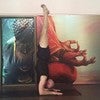Description
Please see attached .pdf below to go along with this lesson.
About This Video
Transcript
Read Full Transcript
Let's talk booty, or the tush, or the tuckus, otherwise known as the gluteal muscles. Now, you have kind of a Papa Bear, Mama Bear, Baby Bear scenario back here, and it really encompasses this back part of the pelvis, back part of the pelvic bowl. The gluteus maximus is actually the second strongest muscle in the body, the first being this masseter muscle, this little tiny muscle on the side of your jaws, quite small but quite mighty, has a big bite, pounds per pressure. But the gluteus maximus is the largest muscle, if you're going by square inches, and the second strongest, it's quite a powerful muscle in the body. And it forms really what we're seeing and kind of appreciating as the part of the rear end, making up the largest point, largest part rather, of the rear end.
Now, if we were to take the gluteus maximus away, we would see on the kind of more lateral side of our ilium, we would see our little fan-shape gluteus medius, and then even smaller still a little fan-shape of the gluteus minimus. Now all of them will attach to the femur, the greater trochanter part of the femur, and as a team, gluteus maximus really is the prime mover of hip extension. It also has a side job of external rotation of the thighs. So when you power up gluteus maximus to 10 and take the legs back behind you, most likely you're going to see your legs turn out like a dancer might turn out. Gluteus medius and minimus tend to be fairly weak and underutilized in practice.
If you've ever done a lot of standing poses on one leg, maybe like an Ardha Chandrasana or a tree pose, and you have to come out of the pose and you kind of want to hit the side of your hip and shake out your leg, that's gluteus medius and minimus going, what the heck, you've never used me before, what are you doing? And so it starts to kind of flip out a little bit and contract or spasm a little, usually a sign that a little more attention and love can be given to this gluteus medius and minimus. Their real job is to take an extension of the leg, they're helpers in that, but really destabilize you when you're on one leg, and also they have a side job of internal rotation of the thigh bone, so they're antagonists to that big strong gluteus maximus. Now if we look at the nerves that exit out through this region and we were to take the gluteus maximus, minimus and medius away, we would see underneath these smaller six muscles on either side, almost like cat whiskers, called the external rotators, and their job not surprisingly is to externally rotate our thigh bones. Now if we were to look at these nerves that exit out, looking underneath those external rotators and one in particular that kind of has a little bit of a reputation called the piriformis, we'll see this big branch or bundle of nerves, you can see here in yellow, called the sciatic branch.
Now oftentimes we think of the sciatic nerve as like one puny little nerve, like in the rest of the body, but the sciatic branch actually has root value of L4, L5, S1, S2, S3, S4, all the nerves that exit out bundle up and they're at its thickest part, almost as thick as a big highlighter pen or a big marker, a chunky marker, and it's at its widest, biggest part, right under that piriformis and underneath those glute muscles, smack dab in the center of your tush cheek, and the nerves then begin to move down the back of the leg, under the hamstrings, down the knee, past the knee to the calf, all the way to the sole of your foot, and the sciatic branch sometimes gets in trouble when one of those muscles begins to clamp down on the sciatic road and causing nerve pain, something that you might have heard of sciatica, sometimes even piriformis syndrome, that's when the piriformis is to blame, but since this has such a great root value, it takes its roots from all of these different places, it's not always piriformis' fault or the butt muscles, the glute muscles' fault, it could be a disc herniation pressing on a nerve that contributes its root to the sciatic branch, it could be the erector spinae muscles or quadratus lumborum, it can be the glute muscles or sacroiliac dysfunction, and it can also be anywhere down the hamstrings back of the leg all the way to the foot causing irritation to this nerve. Now what sometimes is problematic is that we get some instructions from our teachers that may not be appropriate for us, there's no one perfect verbal cue and there's not one that will work for everyone, but let's observe one that I hear quite often of tuck your tail. So in Tadasana, we're striking a balance in the bowl of the pelvis, if you were to rock the pelvis forward like in cow pose, our sacrum is nutating, our bowl is anteriorly tipping like all of the contents of the bowl are falling anterior, if we set the bowl back as if we're doing kind of a cat pose, we're counter-nutating the sacrum and the bowl of the pelvis is posteriorly tilting which like all the contents of the bowl of the pelvis are falling posteriorly and we tend to fall in one of two camps, we're either what I call a pelvic thruster, kind of pushing the pelvis forward, tucking the tail under or we're a booty popper where we're kind of sticking our butt back, maybe a little lordotic in the lumbar back and kind of spilling our abs forward. Now they both are fine, we tend to pick one camp and stay there, but for a movement practice, we're looking to strike maybe a sweeter balance, so establishing kind of a balance in the bowl of the pelvis, it's going to look like you have a butt and that's okay, celebrate it. So the abs can still support around the lumbar spine, the groin crease should feel soft and indented and the butt should feel not grippy and tight but not kind of, you know, wagging in the breeze, it should be kind of semi-firm.
So if you're in Tadasana and your teacher says tuck your tail, most of us come into that pelvic thrusting pose or exaggeration, this hardens the groin, it hardens the quads, it shortens the muscles in the belly and overall everything above and below get a little imbalanced. So if you had a big lordotic curve, maybe that's a good cue for you of drop your tail down or lift your belly in, maybe worse comes to worse you can say tuck your tail under but it's definitely not right for everyone. I also hear this show up a lot in the pose, Utkatasana or chair pose, so when we come into chair, the same thing, some people might present with sticking their butt way out behind them but a lot of what I see is people kind of curling their pelvis forward into that kind of pelvic thrust action and a cue like tuck your tail under just brings that even more into existence, definitely not very freeing for your lower back or supportive. So I think again just dropping back, sitting your tush low and feeling a balance in the bowl of the pelvis, maybe or maybe not tucking but watching that cue it may not be appropriate for you. You also see this quite a lot in back bending.
So if we were to look at a pose like bridge pose, a lot of times when we come into a back bend because this is extension of our thigh bones, we're using gluteus maximus and we're using, we're revving it up to 10 so much that our knees might splay out and our thighs might start to externally rotate. And then I also hear that cue from teachers, tuck your tail under. I think that emphasizes that action and causes a lot of tension where it doesn't really need to be that. This is also not very sweet for the knees or for the sac or iliac or lumbar region. This is why sometimes a teacher might bring a block in between your thighs so you're turning down the volume of your gluteus maximus as you lift and refining the action with the inner maybe outer thighs or outer tush muscles so you're lifting in a more balanced way.
It may not look as high. I can get a lot higher if I turn my legs out and rev my glutes up to 10 but really causes more tension than it's worth. So as we move through the next few regions of the thighs, we'll keep in mind that this balanced action is really the way to go.
Your Body on Yoga: Torso
Comments
You need to be a subscriber to post a comment.
Please Log In or Create an Account to start your free trial.
















